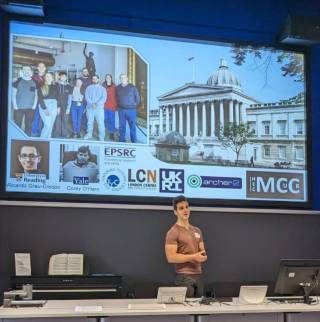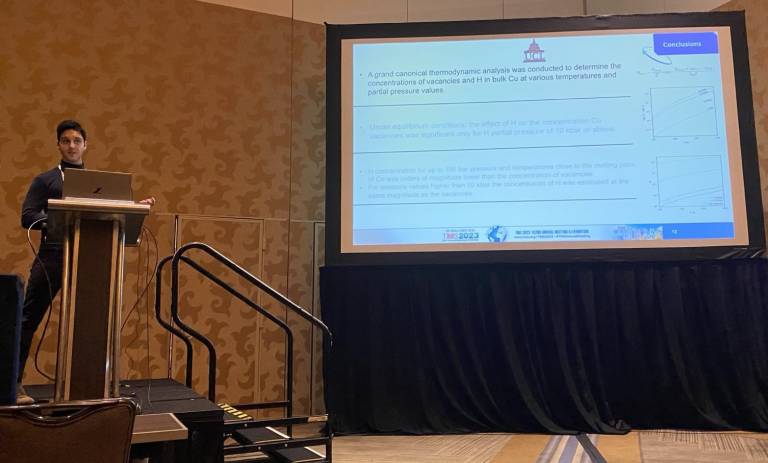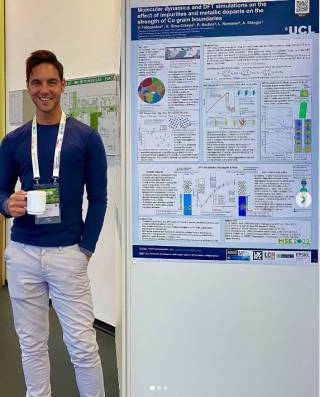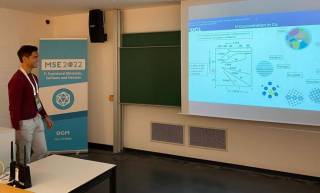HOME | MEMBERS | RESEARCH | PUBLICATIONS | LINKS |
About Me



We combine the efficiency of Molecular Dynamics and semi-empirical/empirical potentials, with the accuracy of quantum mechanical methods to address the issue of degradation effects in metallic systems used as interconnects for electronic devices at a multi-scale level. [1] Bertin, N. 2019, 122, pp.268-284. [2] Khadyko, M. et al. 2021, 228(1), pp.15-31.
In 2016, I graduated from the physics department of the University of Athens, majoring in environmental sciences. My undergraduate studies in Physics have played a fundamental role in my decision to pursue a PhD in molecular modelling. The purpose of my academic thesis entitled "Exploitation of spatial variability of offshore wind energy resources in Greece." Supervised by Prof. George Kallos was to investigate, analyse and assess wind quality and power prospects for various locations in Greece which would be suitable for building an offshore wind power facility and then select the two areas with the maximum combined wind power output.
In 2018, I completed my studies for the MSc in Sustainable Energy Engineering at Queen Mary University of London under the supervision of Prof. Joe Briscoe. The purpose of my research project entitled "Fabrication and optimisation of dye-sensitised and perovskite solar cells based on ZnO nanorods" was the fabrication and optimisation of low-cost solar cells using nanostructures in order to improve their performance. Different fabrication methods and materials are tested and evaluated through Scanning Electron Microscopy, X-ray Powder Diffraction analysis and UV-Vis spectroscopy with the purpose of producing devices that could make solar energy a viable solution for future applications.
I started my PhD at UCL in 2019 as a member of Prof. Alex Shluger's research group.
Research

Cu has been used in a wide range of applications including energy generation, transmission, catalysis and localised surface plasmon resonance. It has been widely used for electrochemical energy storage purposes like in supercapacitors and lithium-ion batteries. Cu is also considered the most reliable and the most commonly used interconnect metal for high-temperature electronics, being used for such applications since the early 1990s. Cu is also considered the most reliable and the most commonly used interconnect metal for high-temperature electronics, being used for such applications since the early 1990s.
Despite the number of benefits that Cu interconnects brought, still, important disadvantages have been reported. Cu interconnects were found to suffer from electromigration issues along with lower stress-migration resistance. Cu has shown poor adhesion, which resulted in significant device performance issues due to copper's tendency to diffuse into surrounding materials, leading to severe degradation effects. The formation of voids due to the stress loading of metal films has a detrimental effect on the performance of electronic devices, eventually leading to complete failure. Voids, the most commonly occurred defects under such conditions, are thought to be formed by the aggregation of vacancies. However, the mechanism via which vacancies aggregate to form voids is not fully understood. Cu/Me interfaces, with Me referring to bcc metals, such as Nb or W. These interfaces are widely used for electrical and electronic applications. Despite making up only a small percentage of the volume, interfaces in such materials have a major role in determining their electrical, mechanical, thermal and diffusion properties. Yet the structure and interface properties of different Cu/Me interfaces have not been studied in detail. The current study combines the efficiency of Embedded Atom Method (EAM) potentials and the accuracy of density functional theory (DFT) methods to address the issue of degradation effects in Cu at a multi-scale level.
Electrochemical deposition or electroplating (ECD) is considered one of the most attractive deposition methods followed commonly for interconnecting metals. The additives that are involved in the ECD process are known to influence the properties of the deposited Cu. Studies have also emphasised how the inclusion of impurities also affects the formation of crystal defects like dislocations and vacancies. As experimental studies were not able to determine the exact effects that impurities have on the formation of vacancies, a more detailed analysis using theoretical approaches is needed.
Approach
The current study combines the efficiency of Molecular Dynamics and semi-empirical/empirical forcefields with the accuracy of both Gamma-centered and Monkhorst-Pack (MP) k-point sampling density functional theory (DFT) methods to address the issue of degradation effects in Cu at a multi-scale level. For the forcefields, a combination of Embedded Atom Method (EAM), Modified Embedded Atom Method (MEAM) and Bond Order Potentials (BOP) are used. Throughout my Ph.D., I employed atomistic simulation codes such as VASP, CP2K, CASTEP, LAMMPS, and CONQUEST. Using quantum mechanical approaches in tandem with molecular dynamics simulations, the effects that common-non metallic impurities have on these regions can be examined. Hence, the cosegregation of vacancies and certain impurities can give us a good indication of the effects that these contaminants could have on the aggregation and stabilisation of vacancy clusters within these regions.
 Close
Close
















